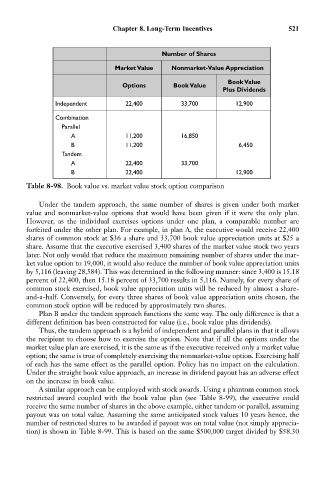Page 535 - Bruce Ellig - The Complete Guide to Executive Compensation (2007)
P. 535
Chapter 8. Long-Term Incentives 521
Number of Shares
Market Value Nonmarket-Value Appreciation
Book Value
Options Book Value
Plus Dividends
Independent 22,400 33,700 12,900
Combination
Parallel
A 11,200 16,850
B 11,200 6,450
Tandem
A 22,400 33,700
B 22,400 12,900
Table 8-98. Book value vs. market value stock option comparison
Under the tandem approach, the same number of shares is given under both market
value and nonmarket-value options that would have been given if it were the only plan.
However, as the individual exercises options under one plan, a comparable number are
forfeited under the other plan. For example, in plan A, the executive would receive 22,400
shares of common stock at $36 a share and 33,700 book value appreciation units at $25 a
share. Assume that the executive exercised 3,400 shares of the market value stock two years
later. Not only would that reduce the maximum remaining number of shares under the mar-
ket value option to 19,000, it would also reduce the number of book value appreciation units
by 5,116 (leaving 28,584). This was determined in the following manner: since 3,400 is 15.18
percent of 22,400, then 15.18 percent of 33,700 results in 5,116. Namely, for every share of
common stock exercised, book value appreciation units will be reduced by almost a share-
and-a-half. Conversely, for every three shares of book value appreciation units chosen, the
common stock option will be reduced by approximately two shares.
Plan B under the tandem approach functions the same way. The only difference is that a
different definition has been constructed for value (i.e., book value plus dividends).
Thus, the tandem approach is a hybrid of independent and parallel plans in that it allows
the recipient to choose how to exercise the option. Note that if all the options under the
market value plan are exercised, it is the same as if the executive received only a market value
option; the same is true of completely exercising the nonmarket-value option. Exercising half
of each has the same effect as the parallel option. Policy has no impact on the calculation.
Under the straight book value approach, an increase in dividend payout has an adverse effect
on the increase in book value.
A similar approach can be employed with stock awards. Using a phantom common stock
restricted award coupled with the book value plan (see Table 8-99), the executive could
receive the same number of shares in the above example, either tandem or parallel, assuming
payout was on total value. Assuming the same anticipated stock values 10 years hence, the
number of restricted shares to be awarded if payout was on total value (not simply apprecia-
tion) is shown in Table 8-99. This is based on the same $500,000 target divided by $58.30

